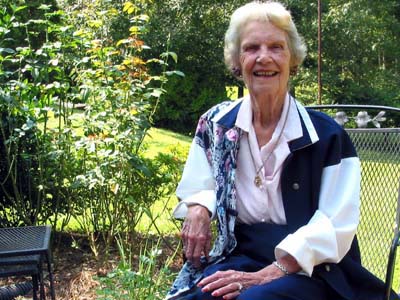PEARL, Miss.—Thelma Andrews is a 90-year-old who doesn’t believe in living life on the sidelines.
So when the pain of three spinal fractures made her practically bedridden, the Pearl woman struggled with the idea of losing her go-getter lifestyle. “I have a horror of being where I can’t get up and move around,” she said. “It is hard to just sit.”
Fortunately for Andrews, she no longer has to. A recent surgery at Methodist Rehabilitation Center in Jackson eased her pain and put her back on her feet. Called kyphoplasty, the increasingly popular procedure can offer instantaneous pain relief by correcting deformities caused by compression fractures in the vertebrae of the spine.
“It’s pretty impressive,” said Andrew’s surgeon, Dr. Ash Ragab, an associate professor of orthopedics at the University of Mississippi Medical Center in Jackson. “People don’t require bracing afterward and they can walk immediately after surgery.”
Ragab said vertebral compression fractures occur when the bones in the spine weaken and collapse – usually the result of low bone mass caused by the disease osteoporosis.
While many such fractures go unnoticed, others can be painful and disabling. The fractures can cause the spine to bend forward, forming the rounded back and stooped posture commonly referred to as a dowager’s hump. This deformity shifts the patient’s center of gravity, straining back muscles and ligaments and affecting posture and height.
Ragab said other complications of vertebral compression fractures include compression of the chest and abdomen, decreased lung function, decreased appetite, greater dependence on family or caregivers, sleep disorders and anxiety/depression. The risk of dying after a spinal fracture also is increased. “The mortality risk goes up eight-fold,” Ragab said.
Most vertebral compression fractures are treated with bed rest, pain medication and the use of a brace for support. But that approach doesn’t work for everyone, especially those with a dowager’s hump.
“Sometimes elderly patients don’t tolerate bracing that well, and braces don’t correct the deformity,” Ragab said. “You want to bring the bone back to its natural position.”
Kyphoplasty can accomplish that goal, said Ragab, and it’s safer than other forms of surgery because it’s minimally invasive.
To perform the procedure, surgeons use an imaging machine known as the fluoroscope to project live x-rays of the front, back and side of the patient’s spine onto two screens. Aided by this view, surgeons guide two inflatable orthopedic balloons through a large needle and into the collapsed area of the spine. Once the balloons are gently inflated, the fractured bone fragments are restored to their original shape. The balloons are then deflated and removed, leaving a cavity. This cavity is filled with bone cement, which hardens and stabilizes the fracture.
As with any surgery, kyphoplasty has its risks. Ragab does not recommend kyphoplasty for people who have fractures in the spinal canal that the cement might leak into and cause paralysis. Nor is it appropriate for people who might not tolerate the procedure because they have other illnesses.
“It’s mainly for elderly people who are in such chronic pain that they’re unable to do their daily activities,” he said.
Andrews had reached that point. Even so, Johnson admits she had some reservations about her mother undergoing surgery. “But mother said: ‘I’ll take my chances.’ She didn’t want to be down.”
Today, Andrews is back to her usual routine, and so happy with the outcome of her surgery that she’s willing to try kyphoplasty again to fix another fracture that has been found in her spine.
“She has gotten her quality of life back,” Johnson said. “If you could have seen how she was before, the pain she was in … I am thrilled with the results.”
While kyphoplasty can deliver almost “magical” pain relief, Ragab stresses that “the best thing is prevention.” He recommends seeing a rheumatologist if you have signs of osteoporosis, such as severe back pain, loss of height or spinal deformities such as stooped posture.
Dr. David Collipp, a rehabilitation physician at Methodist, says people can help avoid osteoporosis-related fractures by practicing a healthy lifestyle. He recommends a balanced diet rich in calcium and vitamin D, a regular routine of weight-bearing exercises, no smoking or excessive alcohol intake and bone density testing and medication when appropriate.
Risk Factors for Osteoporosis
- A history of fracture after age 50
- Low bone mass
- Being female
- Being thin and/or having a small frame
- Advanced age
- A family history of osteoporosis
- Estrogen deficiency
- Abnormal absence of menstrual periods
- Low lifetime calcium intake
- Taking certain medications such as corticosteroids and anticonvulsants
- Low testosterone levels in men
- An inactive lifestyle
- Current cigarette smoking
- Excessive use of alcohol
- Being Caucasian or Asian, although African
- Americans and Hispanic Americans also are at significant risk
Source: National Osteoporosis Foundation

